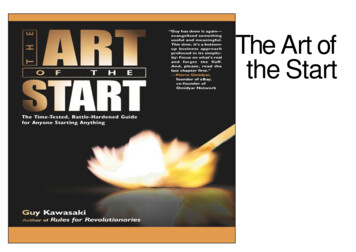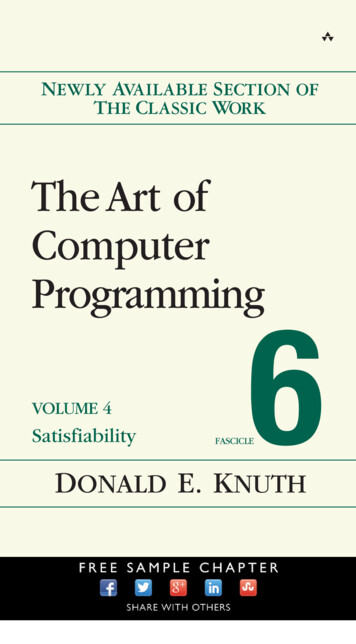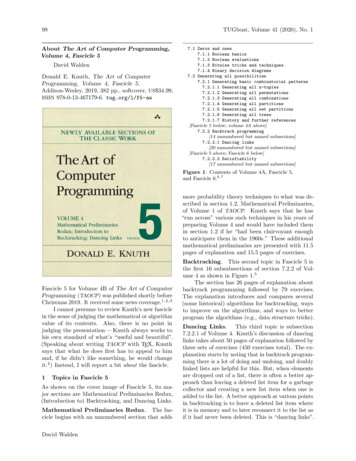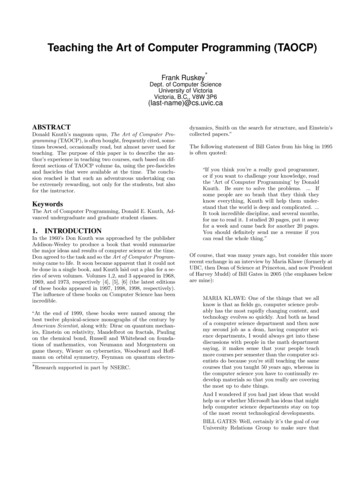
Transcription
The Art ofthe Start
ARTAlso by Guy KawasakiDatabase 101HindsightsHow to Drive Your Competition CrazyOFRules for the RevolutionariesTHESelling the DreamThe Computer CurmudgeonSTARTThe Macintosh Way\THE TIME-TESTED,BATTLE-HARDENED GUIDE FORANYONE STARTING ANYTHINGGuy Kawasaki
PORTFOLIOPublished by the Penguin GroupPenguin Group (USA) Inc., 375 Hudson Street, New York, New York 10014, U.S.A.Penguin Group (Canada), 10 Alcorn Avenue, Toronto, Ontario, Canada M4V 3B2(a division of Pearson Penguin Canada Inc.)Penguin Books Ltd, 80 Strand, London WC2R ORL, EnglandPenguin Ireland, 25 St Stephen's Green, Dublin 2, Ireland (a division of Penguin Books Ltd)Penguin Books Australia Ltd, 250 Camberwell Road, Camberwell, Victoria 3124,Australia (a division of Pearson Australia Group Pty Ltd)Penguin Books India Pvt Ltd, 11 Community Centre, Panchsheel Park, New Delhi 110 017, IndiaPenguin Group (NZ), Cnr Airborne and Rosedale Roads, Albany, Auckland,New Zealand (a division of Pearson New Zealand Ltd) .Penguin Books (South Africa) (Pty) Ltd, 24 Sturdee Avenue, Rosebank, Johannesburg2196, South AfricaA child is the ultimate startup, and I have three.First published in 2004 by Portfolio,a member of Penguin Group (USA) Inc.1514This makes me rich.13Copyright Guy Kawasaki, 2004All rights reserved iPublisher's NoteThis publication is designed to provide accurate and authoritative information in regard tothe subject matter covered. It is sold with the understanding that the publisher is not engaged in rendering legal, accounting, or other professional services. If you require legal advice or other expert assistance, you should seek the services of a competent professional.LIBRARY OF CONGRESS CATALOGING-IN-PUBLICATION DATAKawasaki, Guy, 1954The art of the start: the time-tested, battle-hardened guide for anyone startinganything / Guy Kawasaki.p. cm.Includes bibliographical references and index.ISBN 1-59184-056-21. New business enterprises. 2. Entrepreneurship. I. Title.HD62.5.K38 2004658.l'l—dc22—Halford E. LuccockTo my children: Nic, Noah, and Nohemi.Penguin Books Ltd, Registered Offices:80 Strand, London WC2R ORL, England16Many years ago Rudyard Kipling gave an address at McGill University in Montreal. He said one striking thing which deserves to be remembered. Warning the students against an over-concern for money,or position, or glory, he said: "Some day you will meet a man whocares for none of these things. Then you will knoiv how poor you are."2004044773This book is printed on acid-free paper. Printed in the United States of AmericaSet in SabonDesigned by BTD NYCWithout limiting the rights under copyright reserved above, no part of this publication maybe reproduced, stored in or introduced into a retrieval system, or transmitted, in any form orby any means (electronic, mechanical, photocopying, recording or otherwise), without theprior written permission of both the copyright owner and the above publisher of this book.The scanning, uploading, and distribution of this book via the Internet or via any othermeans without the permission of the publisher is illegal and punishable by law. Please purchase onlv authorized electronic editions and do not participate in or encourage electronic
Acknowledgments In giving advice, seek to help, not please, your friend.—Solony thanks to all the people who helped me with this book.MFirst, Rick Kot at Viking, because this book was his idea.Furthermore, he tolerated my crazy ideas—including thetitle and subtitle and having a cover-design contest. Everyauthor should be so lucky to work with an editor like Rick. (The con-verse is not necessarily true.)Second, Patty Bozza and Alessandra Lusardi of Viking, and thePortfolio team: Joe Perez, Will Weisser, and Adrian Zackheim, as wellas Lisa "Her Highness" Berkowitz. Behind every successful authorstands an amazing team.Third, a group of readers who truly sought to help, not please,me. They spent many hours reading and refining my drafts. My eternalgratitude to: Marylene Delbourg-Delphis, George Grigoryev, RonitHaNegby, Heidi Mason, Bill Meade, John Michel, Anne P. Mitchell,Lisa Nirell, Bill Reichert, Gary Shaffer, Rick Sklarin, and Andrew Tan.Fourth, a group of people who contributed by making suggestions, course corrections, and additions. They are: Mohamed AbdelRahman, Anupam Anand, Imran Anwar, Dave Baeckelandt, A. J.Balasubramanian, Steve Bengston, David Berg, Scott Butler, Tom Byers, Antonio Carrero, Lilian Chau, Pam Chun, Tom Corr, StephenCox, Deborah Vollmer Dahlke, Martin Edic, Bob Elmore, Eric Erickson, Elaine Ferre, Pam Fischer, Sam Hahn, Lenn Hann, Steve Holden,Hilary Horlock, Katherine Hsu, Doug Ito, Bill Joos, John Michel,Cindy Nemeth-Johannes, Tom Kosnik, Pavin Lall, Les Laky, Molly\/M
Lavik, Eric "I'm Open" Lier, Anthony Lloyd, Robert MacGregor,Tom J teade, Chris Melching, Fujio Mimomi, Geoffrey O'Neill, BolaOdulate, Colin Ong, Steve Owlett, Lakiba Pittman, Gina Poss, JuliePound, Warrick Poyser, the Propon Team, Richard Putz, Anita Rao,Jim Roberts, Marty Rogers, John Roney, Aaron Rosenzweig, MichaelRozenek, Brian Rudolph, David Schlitter, John Scull, Izhar Shay, MarcSirkin, Marty Stogsdill, Judy Swartley, Russ Taylor, Larry Thompson,Amy Vernetti, Ryan Walcott, Shelly Watson, Tim Wilson, Ryan Wong,and Jan Zones.Fifth, the people who helped me to market this book: AlyssaFisher, Sandy Kory, Tess Mayall, Ruey Feng Peh, Shifeng Li, ShyamSankar, Betty Taylor, and Kai Yang Wang.ContentsA friend is one to whom you can pour out the contents ofyour heart, chaff and grain alike. Knowing that the gentlest ofhands will take and sift it, keep what is worth keeping, andwith a breath of kindness, blow the rest away.—anonymousRead Me FirstSixth, my loving and lovely wife, Beth. Thank you for bearingwith me as I wrote this book during a very busy time in our lives, andfor the best twenty years of my life.CausationSeventh, Sloan Harris of International Creative Management.Thank God for Sloan—otherwise, Rick Kot and Portfolio would haveeaten me alive.ArticulationEighth, Patrick Lor and the gang at iStockPhoto.com who helpedthis graphically challenged author.Finally, John Baldwin, Ruben Ayala, and Ken Yackel of the IceOasis Skating and Hockey Club. Were it not for them, I would havefinished this book six months earlier. But then I wouldn't be the bestfifty-year-old, transplanted Hawaiian, beginner ice hockey player inSilicon Valley. And this is certainly a desirable niche to fill.Chapter 1: The Art of Startingxi3Chapter 2: The Art of Positioning29Chapter 3: The Art of Pitching44Chapter 4: The Art of Writing a Business Plan66ActivationChapter 5: The Art of Bootstrapping79Chapter 6: The Art of Recruiting100Chapter 7: The Art of Raising Capital119ProliferationChapter 8: The Art of Partnering151Chapter 9: The Art of Branding167Chapter 10: The Art of Rainmaking192ObligationVlllChapter 1 1 : The Art of Being a Mensch211Afterword217Index219ix
Read Me FirstThe most exciting phrase to hear in science, the one that heraldsnew discoveries, is not "Eureka!" (I found it!) but "That's funny. . . . "— Isaac Asimovhere are many ways to describe the ebb and flow, yin andyang, bubble-blowing and bubble-bursting phases of business cycles. Here's another one: microscopes and telescopes.In the microscope phase, there's a cry for level-headedthinking, a return to fundamentals, and going "back to basics."Experts magnify every detail, line item, and expenditure, and thendemand full-blown forecasts, protracted market research, and allencompassing competitive analysis.In the telescope phase, entrepreneurs bring the future closer.They dream up "the next big thing," change the world, and makelate-adopters eat their dust. Lots of money is wasted, but some crazyideas do stick, and the world moves forward.When telescopes work, everyone is an astronomer, and the worldis full of stars. When they don't, everyone whips out their microscopes, and the world is full of flaws. The reality is that you need bothmicroscopes and telescopes to achieve success.The problem is that this means gathering information that isspread among hundreds of books, magazines, and conferences. It alsomeans talking to dozens of experts and professionals—if you can get,and afford, an audience. You could spend all your time learning andnot doing. And doing, not learning to do, is the essence of entrepreneurship.The Art of the Start alleviates this pain. My goal is to help youuse your knowledge, love, and determination to create somethingYl
great without getting bogged down in theory and unnecessary details.My4kpresumption is that your goal is to change the world—not studyit. If your attitude is "Cut the crap and just tell me what I need to do,"you've come to the right place.You might be wondering, Who, exactly, is "you"? The reality isthat "entrepreneur" is not a job title. It is the state of mind of peoplewho want to alter the future. (It certainly isn't limited to Silicon Valley types seeking venture capital.) Hence, this book is for people in awide range of startup endeavors:9guys and gals in garages creating the next great company brave souls in established companies bringing new products andservices to market saints starting schools, churches, and not-for-profitsGreat companies. Great divisions. Great schools. Great churches.Great not-for-profits. When it comes to the fundamentals of startingup, they are more alike than they are different. The key to their success is to survive the microscope tasks while bringing the future closer.Let's get started.Guy KawasakiPalo Alto, CaliforniaKawasaki@garage.comCausation
CHAPTER1The Art ofStartingEveryone should carefully observe which way his heartdraws him, and then choose that way with all his strength.—Hasidic sayingGIST (GREAT IDEAS FOR STARTING THINGS)use a top-ten list format for all my speeches, and I would love tobegin this book with a top-ten list of the most important things anentrepreneur must accomplish. However, there aren't ten—thereare only five:1. MAKE MEANING (inspired by John Doerr). The best reason to startan organization is to make meaning—to create a product or servicethat makes the world a better place. So your first task is to decide howyou can make meaning.2. MAKE MANTRA. Forget mission statements; they're long, boring, andirrelevant. No one can ever remember them—much less implementthem. Instead, take your meaning and make a mantra out of it. Thiswill set your entire team on the right course.3. GET GOING. Start creating and delivering your product or service.Think soldering irons, compilers, hammers, saws, and AutoCAD—q
whatever tools you use to build products and services. Don't focus onfetching, writing, and planning.4. DEFINE YOUR BUSINESS MODEL. No matter what kind of organization you're starting, you have to figure out a way to make money.The greatest idea, technology, product, or service is short-lived without a sustainable business model.5. WEAVE A MAT (MILESTONES, ASSUMPTIONS, AND TASKS). Thefinal step is to compile three lists: (a) major milestones you need tomeet; (b) assumptions that are built into your business model; and(c) tasks you need to accomplish to create an organization. This willenforce discipline and keep your organization on track when all hellbreaks loose—and all hell will break loose.The truth is that no one really knows if he* is an entrepreneur until he becomes one—and sometimes not even then. There really is onlyone question you should ask yourself before starting any new venture:Do I want to make meaning}Meaning is not about money, power, or prestige. It's not evenabout creating a fun place to work. Among the meanings of "meaning" are to Make the world a better place.Increase the quality of life.Right a terrible wrong.Prevent the end of something good.Goals such as these are a tremendous advantage as you travelMAKE MEANINGdown the difficult path ahead. If you answer this question in the neg-/ have never thought of writing for reputation and honor. What Ihave in my heart must come out; that is the reason why I compose.—Ludwig van BeethovenMany books about entrepreneurship begin with a rigorous process ofself-examination, asking you to determine if you are truly up to thetask of starting an organization. Some typical examples areative, you may still be successful, but it will be harder to become sobecause making meaning is the most powerful motivator there is.It's taken me twenty years to come to this understanding.In 1983, when I started in the Macintosh Division of AppleComputer, beating IBM was our reason for existence. We wanted tosend IBM back to the typewriter business holding its Selectric typewriter balls.In 1987, our reason for existence became beating Windows and Can you work long hours at low wages?Microsoft. We wanted to crush Microsoft and force Bill Gates to get Can you deal with rejection after rejection?a job flipping fish at the Pike Place Market. Can you handle the responsibility of dozens of employees?In 2004,1 am a managing director in an early-stage venture capital firm called Garage Technology Ventures. I want to enable people toThe truth is, it is impossible to answer questions like this in advance, and they ultimately serve no purpose. On the one hand, talkand bravado are cheap. Saying you're willing to do something doesn'tmean that you will do it.On the other hand, realizing that you have doubt and trepidationdoesn't mean you won't build a great organization. H o w you answerthese questions now has little predictive power regarding what you'llactually do when you get caught up in a great idea.4create great products, build great companies, and change the world.The causation of great organizations is the desire to make meaning. Having that desire doesn't guarantee that you'll succeed, but it doesmean that if you fail, at least you failed doing something worthwhile.''If only defeating sexism were as simple as throwing in an occasional he/she, she, her, orhers. I use the masculi
The art of the start: the time-tested, battle-hardened guide for anyone starting anything / Guy Kawasaki. p. cm. Includes bibliographical references and index. ISBN 1-59184-056-2 1. New business enterprises. 2. Entrepreneurship. I. Title. HD62.5.K38 2004 658.l'l—dc22 2004044773 This book is











